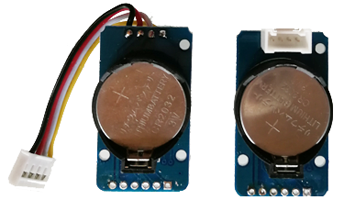16. Real-time Clock
RTC-Module
An external real-time clock (RTC) with a battery can be used to automatically restore the current date-time when the micro:bit is switched on. For the connection to the I2C hub either a Grove cable or a Grove plug is soldered in.
The RTC chip stores the current date-time (year, month, day, hour, minute, second, weekday). By calling set(yyyy, mm, dd, h, m, s, w) you set the current date-time. As long as the power supply by the button cell is maintained, the date-time is moved forward automatically and can be retrieved with get().
|
|
|
Example 1: The program first sets the date-time to a start value and then displays it periodically
# Rtc1.py
import rtc
from microbit import *
rtc.set(2019, 7, 11, 14, 55, 20, 2)
while True:
data = rtc.get()
display.scroll("%02d:%02d:%02d" % (data[3], data[4], data[5]))
delay(10000)
|
|
|
Explanations of the program code:
 |
rtc.set(2019, 7 ,11, 14, 55, 20, 2) :Sets the date-time to June 11, 2019, 14:55:20 and weekday 2 (usually Monday). After the first run, this line can be commented out, and the program shows the correct time at each start |
NTP time server
Internet time servers offer time services for several hundred million systems worldwide. They use a standardized data format, the Network Time Protocol (NTP).
Example 2: Getting and displaying current time retrieved from time server
To access the Internet, the ESP32 logs on to an access point, retrieves the time information in raw format first from the standard server pool.ntp.org and then in string format from the server ch.pool.ntp.org. The module ntptime is used.
# Rrc2.py
import linkup
import ntptime
linkup.connectAP("mySSID", "myPassword")
data = ntptime.getTimeRaw()
print("Current time raw:", data)
data = ntptime.getTime("ch.pool.ntp.org")
print("Current time:", data)
|
|
|
Explanations of the program code:
 |
getTimeRaw(): Returns the time information as tuple (yyyy, mm, dd, h, m, s, weekday, dayofyear) |
Example 3: Setting the real-time clock using a NTP server
An NTP server can be used to synchronize the RTC. This method is often used on PCs.
# Rtc3.py
from microbit import *
import linkup
import ntptime
import rtc
print("Requesting time...")
linkup.connectAP("mySSID", "myPassword")
tme = ntptime.getTimeRaw()
print("Got:", tme)
rtc.set(tme)
while True:
data = rtc.get()
display.scroll("%02d:%02d:%02d" % (data[3], data[4], data[5]))
delay(10000)
|
|
|
Explanations of the program code:
